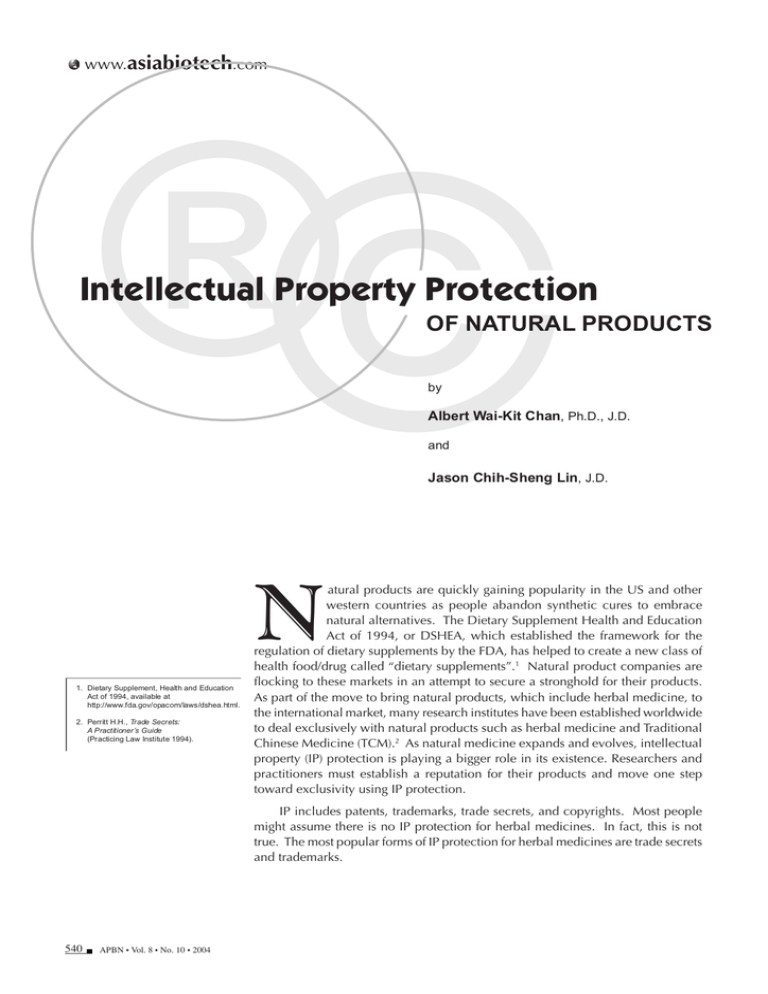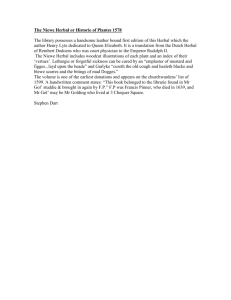Intellectual Property Protection
advertisement

www.asiabiotech.com ®© Intellectual Property Protection OF NATURAL PRODUCTS by Albert Wai-Kit Chan, Ph.D., J.D. and Jason Chih-Sheng Lin, J.D. N 1. Dietary Supplement, Health and Education Act of 1994, available at http://www.fda.gov/opacom/laws/dshea.html. 2. Perritt H.H., Trade Secrets: A Practitioner’s Guide (Practicing Law Institute 1994). atural products are quickly gaining popularity in the US and other western countries as people abandon synthetic cures to embrace natural alternatives. The Dietary Supplement Health and Education Act of 1994, or DSHEA, which established the framework for the regulation of dietary supplements by the FDA, has helped to create a new class of health food/drug called “dietary supplements”.1 Natural product companies are flocking to these markets in an attempt to secure a stronghold for their products. As part of the move to bring natural products, which include herbal medicine, to the international market, many research institutes have been established worldwide to deal exclusively with natural products such as herbal medicine and Traditional Chinese Medicine (TCM).2 As natural medicine expands and evolves, intellectual property (IP) protection is playing a bigger role in its existence. Researchers and practitioners must establish a reputation for their products and move one step toward exclusivity using IP protection. IP includes patents, trademarks, trade secrets, and copyrights. Most people might assume there is no IP protection for herbal medicines. In fact, this is not true. The most popular forms of IP protection for herbal medicines are trade secrets and trademarks. 540 APBN • Vol. 8 • No. 10 • 2004 Trade Secrets 2. Perritt H.H., Trade Secrets: A Practitioner’s Guide (Practicing Law Institute 1994). Trade secrets afford protection for guarded things such as secret ingredients and recipes. Coca-Cola’s formula is one of the best examples of a trade secret. Trade secrets are not registered with any agency; they are maintained within a company, institute or person’s head. The most difficult part of maintaining a trade secret is keeping its secret limited to a small number of loyal people. Trade secrets need to provide a competitive advantage for the trade secret owner.2 In order to determine whether a natural product or an herbal medicine invention, which could qualify for a patent, should instead be maintained as a trade secret, the following questions should be considered: • If patented, can the invention be easily enforced? For example, if the invention is a composition of matter, i.e. a product, and the infringer sells an infringing product on the market, then the infringer could be easily identified. In contrast, if the invention is a method which relates to a manufacturing process, the enforcement of the patent will be more difficult because the patentee may need to go onsite to identify the infringing activity. • Can the patented invention be easily circumvented? • Is the life of the patented invention relatively short? • Does the patent disclosure give competitors an edge? • Does the inventor want to publish the invention? • Will it be difficult to maintain the trade secret? • Is the invention in an active area of research? There are a number of advantages to trade secret protection, namely: • The expenses of obtaining patent protection and enforcing patent rights are not encountered when trade secret protection is used. However, the trade secret owner still must take reasonable measures to maintain the confidentiality of the trade secret. • There is no time limitation for trade secret protection. The only limitation is that secrecy must exist. • Competitors are not apprised of the trade secret, as contrasted to the full disclosure required for a patented invention. • A trade secret does not have to be a patentable invention; it just must be unique and secret. 3. 21 C.F.R. 201.66(c) Format and content requirements for over-the-counter (OTC) drug product labeling, available at http://www.accessdata.fda.gov/scripts/cdrh/ cfdocs/cfCFR CFRSearch.cfm?FR=201.66. 4. Paula Kurtzweil, An FDA Guide to Dietary Supplements, available at http:// www.fda.gov/fdac/features/1998/ 598_guid.html However, for certain products, such as natural health supplements, trade secret may not be available. For instance, current US Food and Drug Administration (FDA) regulation requires that all over-the-counter (OTC) drug labels disclose certain information, including the established name and quantity of the active ingredient, and the inactive ingredient contained in the OTC drug.3 Furthermore, DSHEA requires that labels of dietary supplements must include information such as statement of identity (e.g. “ginseng”), quantity of the contents, directions for use, and supplement facts, including the name and quantity of the active ingredient.4 APBN • Vol. 8 • No. 10 • 2004 541 www.asiabiotech.com Trademarks A trademark is a unique mark (i.e. the name of the product presented on signs or packages) which can be used to protect an herbal medicine’s reputation. Manufacturers identify a federally registered trademark with a circled R symbol, i.e. “®”. Trademarks are consumer oriented. They offer the end user a guarantee of quality, service, and product image. This is the reason that many diners choose McDonald’s over other fast food restaurants. The trademark next to the McDonald’s name assures consumers that the hamburgers will taste the same in Beijing as they do in New York. In the case of natural or herbal medicines, a trademark can signal to the consumer that the product is sold by the same company that makes other high-quality health food products. This is particularly important because lots of natural products bear similar names or packaging. For example, there are more than 60 Ginkgo Biloba products now on the market. A trademark must be distinctive and must be used continuously in order to be deemed valid. Non-use of the trademark in the market would establish a prima facie case of abandonment. Trademarks also must be in use at the time an application for trademark is submitted. An applicant may file an intent to use the trademark up to three years prior to actual use, but the applicant must provide proof that the mark is used within the time period indicated. It is definitely worth spending time to choose the right trademark for a product. Any trademark applicant needs to make an effort to understand the US culture and market, and pick a mark which will be acceptable to the end user. In the case of natural or herbal medicine, this end user could be an ordinary person interested in protecting or improving his/her health, a medical doctor, a drug store, a managed health care formulary, etc. Patents 5. 35 U.S.C. §154(a)(1). Patents may provide the strongest IP protection, but they are also the most difficult IP protection to obtain for natural or herbal medicines. Patents provide the patentee the rights to exclude others from making, using, selling, offering for sale, or importing the patented invention.5 To qualify for a patent, an invention must be novel, useful and not obvious. Most natural or herbal medicines have been used or practiced for years, in the case of TCM for thousands of years; thus, their novelty comes into question. Also, the product being patented cannot have been publicly used or known, as most TCM is. Several common ways that inventors can obtain patents for herbal medicines are if they can: (1) find new uses for an existing herb; (2) isolate a new active ingredient or (3) improve the method for extraction of the active ingredient(s). There are several ways to patent natural or herbal medicines such as by claiming new uses for old compounds. The basic recipe or composition for most Chinese herbal medicine has been known for years and, therefore, is not patentable. Researchers who can find something new about herbal medicines, e.g. a new use for old compounds, may be able to apply for patent protection. One problem with patenting natural or herbal medicines, particularly Chinese herbal medicines, is that most of the herbs have been described previously; therefore, they are what we call “publicly known”. Many of them may have also been publicly used, i.e. people at different levels have used the herbs for different purposes. An 542 APBN • Vol. 8 • No. 10 • 2004 herbal medicine composition, the process of making the composition, and the uses of the composition may not be novel since they are either publicly known or have been publicly used. A patent application is separated into the “specification” section and the “claims” section. The specification includes such things as the background of the invention; a description of the invention; embodiments of the invention; figures and tables; information about whether or not the invention has been disclosed to others; and modes for carrying out the invention. The claims define the applicant’s patent rights. For example, a claim might recite: “What is claimed is: (1) A pharmaceutical dosage unit for bolstering immunofunction in healthy and diseased patients, said dosage comprising a mixture of....; (2) A dosage unit according to claim (1) wherein the dosage form is an orally ingestible capsule.; (3) A dosage unit according to claim (2) which comprises 5mg of ..., 25mg of ..., and 50mg of ...; (4) A method according to claim (3) wherein said composition is orally administered to the patient in the form of a tablet 3-4 times a day.” The novelty requirement for patents must be considered in light of the invention. Not everything listed in the specification section of a patent application must be novel, but what is listed in the claims section must be novel. 6. 35 U.S.C. §282. The advantage of having a US patent is that the patentee can exclude others from practicing the claimed invention. More importantly, there is a presumption of validity for an issued US patent.6 It may cost a competitor US$500,000 to tens of millions of dollars to invalidate a US patent. There are a number of big opportunities in the future for patenting natural products and herbal medicines. A. Validation When the active ingredients in natural or herbal medicines are not known, indicators are needed to validate each batch of drugs. In the process of achieving this goal, patentable subject matter(s) (i.e. the indicators used to determine the quality of the product) may be identified. Claims may be directed to protect the indicator(s). Standard(s) needed for comparison and the use of such standard(s) may also be patentable. B. Clinical and/or Animal Studies One characteristic of herbal medicine is that there is a large volume of clinical and/or animal studies for almost every medicine. Having this information on hand, one can determine the effective dosage or the appropriate route of administration. The effective dosage or the appropriate route of administration may not be obvious in light of the prior art and, therefore, may be protected by a new patent. C. New Formulations New formulations which are directed to new dosages and new routes of delivery may be discovered. In the Chinese herbal medical field things such as oral drugs, sprays and dermal patches are uncommon forms of drug delivery. Of course, to seek such protection, data must be provided, which can show the efficacy of such modifications. APBN • Vol. 8 • No. 10 • 2004 543 www.asiabiotech.com D. Active Ingredients The active ingredients contained in natural or herbal medicine, whether classified as single- or multiple-chemical entities, are likely to be patentable. E. Second-Generation Products Another area of focus for natural or herbal medicine makers in seeking patent protection should definitely be second-generation or improved products. Clearly, those active ingredients, which have decoded chemical formulas, can lead to second-generation drugs by merely modifying the chemical formulas’ functional group. If we know the active ingredient(s), we may be able to understand the target protein or biochemical pathway on which the drug is acting. We can then use such a target protein for screening more drugs. F. Authentication Kits The cost of natural or herbal medicine can be high, and fake medicine has been manufactured; therefore, the market demands fast and economical ways to authenticate herbs. Authentication kits would allow buyers to test the medicine. We have been involved in prosecuting patent applications, which are directed to the authentication of herbs using DNA fingerprinting methodology. Protein fingerprinting may also be another way to authenticate the herb or the medicine. For any company or institute, it is important to have a periodic review to examine new findings. If the findings may be a patentable invention, the company must decide whether to file a patent application or maintain the invention as a trade secret. These reviews should be scheduled monthly, or every six months, at the least. Before making a final decision, the company or institute should consult with a professional, e.g. an IP lawyer. It is also extremely important for the entity to establish an IP policy and print a handbook which describes this policy in detail. The policy should recite explicitly to each employee that all inventions created during his/her employment will belong to the company or institute. All the information employees assess should remain confidential unless otherwise stated. A standard employment contract should be in place for incoming employees. The contract should state that it is the employees duty to keep information confidential even after the employee’s has left the job. The contract should also include a non-compete clause. Plant Patent 7. 35 U.S.C. §161. 8. 35 U.S.C. §163. 544 APBN • Vol. 8 • No. 10 • 2004 If the natural product is a plant or plant extract, US law also offers a separate ground of protection. US patent law provides that “whoever invents or discovers and asexually reproduces any distinct and new variety of plant” may obtain a patent.7 Once the patent is granted, the patentee will be able to exclude others from reproducing, selling, using or importing the plant into US.8 The term of the plant patent protection is 20 years from the filing date of the plant patent. Plant Variety Act 9. U.S. Plant Variety Protection Act, Title I, Ch. 4, Sec. 42(a). 10. U.S. Plant Variety Protection Act, Title II, Ch. 8, Sec. 83(b). The Plant Variety Act passed by the Congress in 1970 is another ground that may be used to protect an herbal product. US Plant Variety Protection Act protects any new, distinct, uniform, and stable varieties of sexually reproduced or tuber propagated plants.9 The term of the plant variety protection is 25 years from the date of issuance of the certificate of plant variety protection.10 Conclusion There are still many opportunities for securing IP protection for natural products. As market for these products continues to heat up, the competition for IP rights will become fiercer. There are other innovative, non-IP ways for companies and institutes to monopolize parts of the natural product market, such as monopolizing materials and forming alliances with other entities. About the Authors Albert Wai-Kit Chan is the principal of the Law Offices of Albert Wai-Kit Chan, LLC. Jason Chih-Sheng Lin is an associate at the Law Offices of Albert Wai-Kit Chan, LLC in Whitestone, New York. APBN • Vol. 8 • No. 10 • 2004 545
![Introduction [max 1 pg]](http://s3.studylib.net/store/data/007168054_1-d63441680c3a2b0b41ae7f89ed2aefb8-300x300.png)

